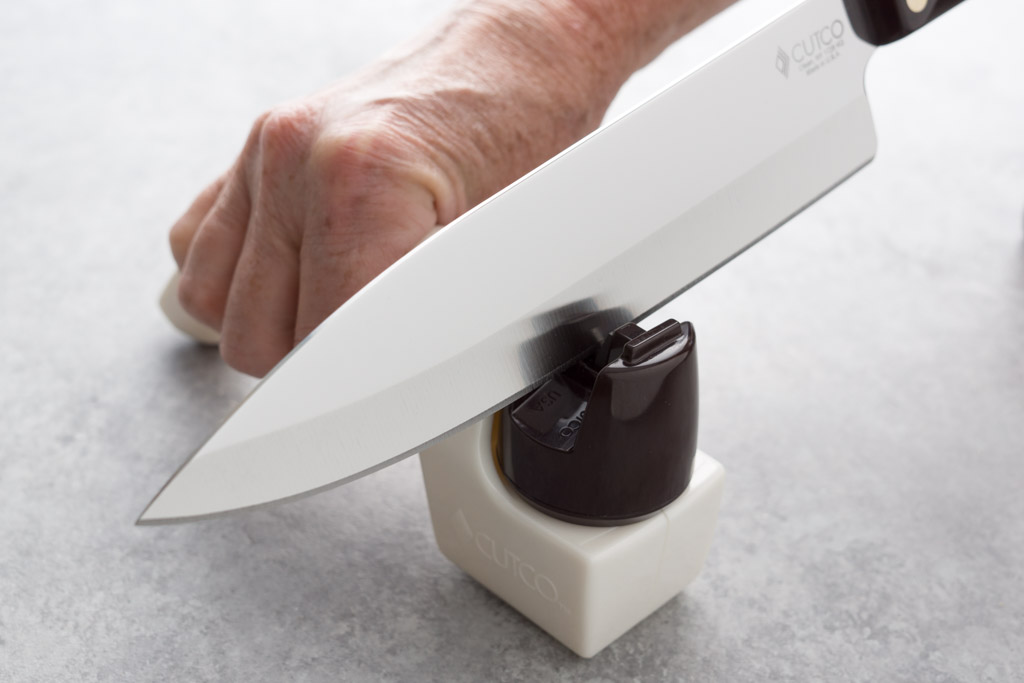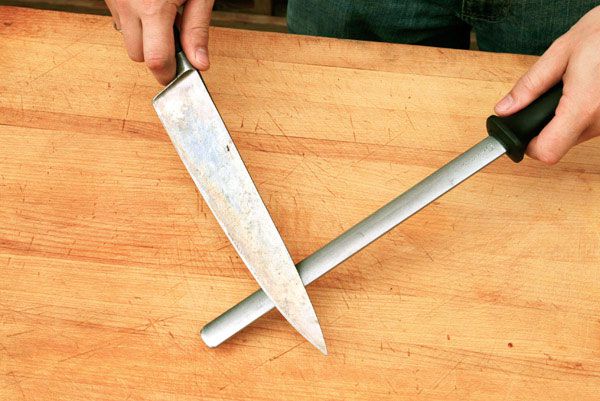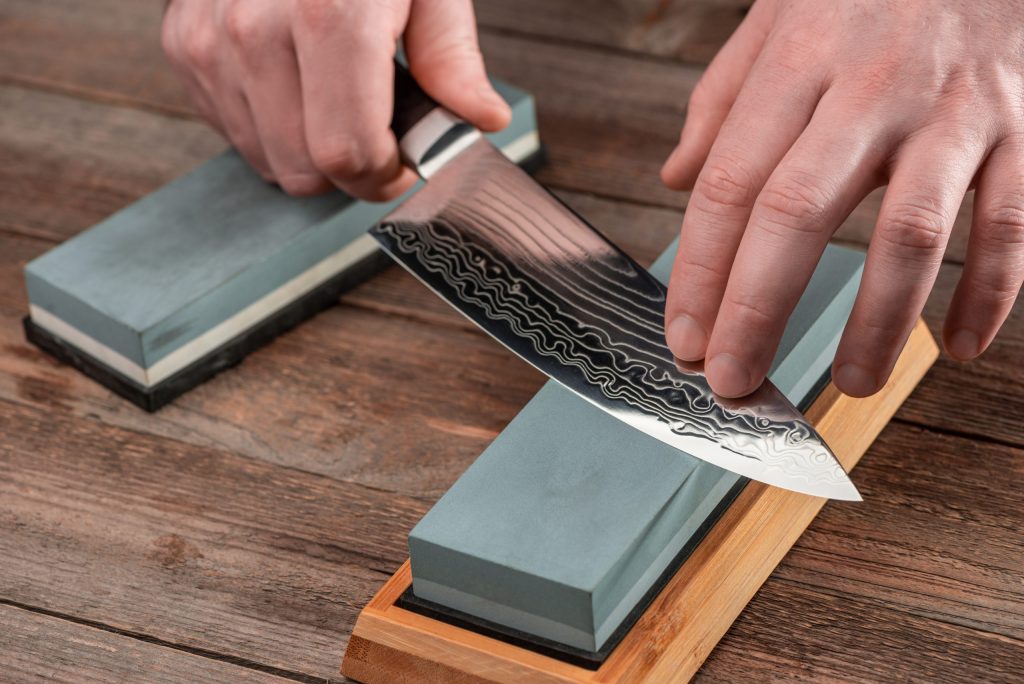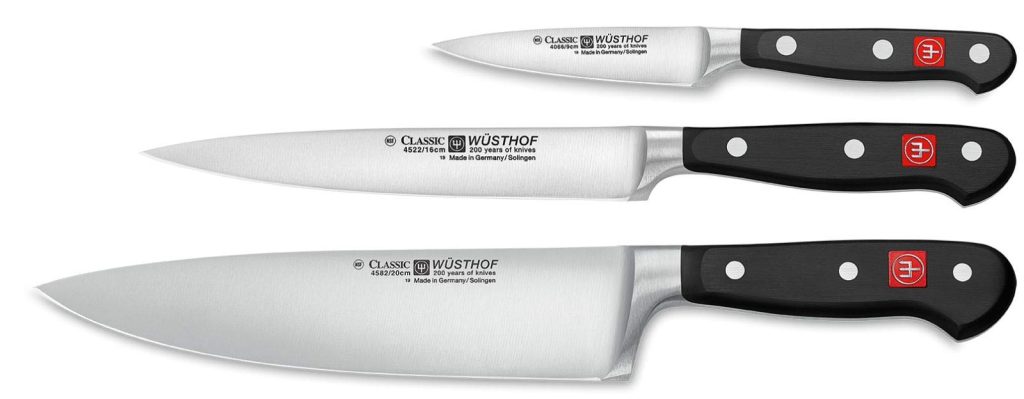How Often Do Professional Chefs Sharpen Their Knives?

My culinary knives are one of my most prized possessions. While I sharpen and hone my knives regularly, I began to question how often should I sharpen a chef’s knife.
As a result, I decided to consult with several chef acquaintances. Here’s what I found out:
You need to only sharpen a chef’s knife a few times a year for everyday household use. Once or twice a week, though, you should hone the edge with steel. However, the quality of the knife, how often it is used, and the sort of food you are cutting all play a role in how often you should sharpen yours.
But there’s a lot more to learn about kitchen knives, sharpening, honing, and frequency. I even observed some surprising distinctions between inexpensive knives and high-end chef’s knives like WÜSTHOF’s.
So let’s start!
Also, look through all of the best chef’s knives, sharpening tools, and steel selections to see what’s best for your kitchen and budget. That link will lead you to a page on this site where you can see all of my top recommendations at various pricing points.
When it comes to chef’s knives, how long should they stay sharp?
A decent chef’s knife shouldn’t need sharpening more than twice a year with everyday household use. However, once or twice a week, you should sharpen your chef knife using steel. Of course, the main question is how frequently you use it and what you’re cutting with it.
For instance, a home cook who cuts onions and garlic a couple of times a week may only need to sharpen their knife a few times a year.
However, as a recovering foodie who uses his chef’s knife for just about anything in the kitchen on a regular basis, including meats and fowl, I sharpen mine around once every 12 weeks or so. However, I only do it if the blade indicates that it is necessary. By stroking my thumb up and down the blade lightly, I can tell if it’s dull.
Also, don’t confuse sharpening with honing.
Sharpening is the process of eliminating microscopic particles of metal from a metal blade, which is what sharpening is. It is simply restoring the knife’s v-shaped edge, and it is not harmful to the knife. On the other hand, honing is done with steel (or sharpening steel), which merely moves the extremely tiny tines of metal into better alignment, resulting in a perfect V shape.
A dull knife will never be sharpened by honing. It will, however, take a sharpened knife and make it appear sharper since the tines will be better formed.
How often should you hone a knife?

Honing your knife should be done every 2-3 times you use it. Honing aligns a knife’s tines that have already been honed, allowing it to cut better and feel sharper.
Unless it’s a carbon steel knife, honing doesn’t have to be done after every usage. So, for most of us who use our kitchen knives at home regularly, once or twice a week is sufficient honing.
When honing a knife, people make two significant errors: over honing and under honing
Can you sharpen a dull knife using sharpening steel, right?
The knife has been over-honed.
So only hone your knife if it’s razor-sharp, to begin with. You obviously know it’s sharp if you just sharpened it. Otherwise, I prefer to feel the edge of the blade by softly rubbing my finger against it. If you’re not sure about that procedure, try slicing through a sheet of paper with your knife.
Is it easy for you to cut the paper with your knife? Then it gets really acute. Before you hone the paper, sharpen it if it bends or buckles or if you have to saw through it like a piece of wood. If your knife is already sharp, a couple of swipes on the sharpening steel should be enough. When I see would-be chefs swiping their knives back and forth on the blade thousands of times, I squirm a little.
The tines are only worn away as a result. Consider the tines to be tiny metal shards (which they are). Every swipe you make on steel bends it somewhat.
What occurs when a piece of metal is repeatedly bent back and forth?
Yes, it deteriorates with time and will eventually break. If the knife is already sharp, a couple of swipes should be sufficient.
Is it necessary to use a whetstone on a regular basis?

Depending on how often you use your chef knife, you should sharpen it on a whetstone 2-3 times a year. Whetstones, often known as water stones, are a type of sharpening stone. A whetstone is used dry, but a water stone is soaked in water before sharpening. A sharpening stone is occasionally bathed in oil before sharpening, despite its name.
The concept behind using oil and water is that it helps hold the grit of the stone in place, making it easier to sharpen the knife. I found that using oil gummed up the stone and knife in my experience. As a result, when I grind my blades, I now use a dry whetstone. Perhaps a spritz of water would suffice.
How often you sharpen it depends on how often you use it and what you’re cutting, just like any other sharpener.
Professional chefs sharpen their knives with a whetstone once or twice a month and hone on steel virtually every day. However, for home cooks, a whetstone once or twice a year and steel once or twice a month is probably all that’s required to keep blades consistently sharp.
What is the best way to sharpen chef knives?

The best way to sharpen chef knives is to use two separate whetstones, one with a hard grit and the other with a light grain. Start with the coarser grit and a tiny amount of water. When the blade starts to feel sharp, move to a lighter grit.
However, if you ask ten cooks what the “best” of something is, you’ll probably receive ten different replies.
Let’s start with the most typical approaches:
- Whetstone/Water stone
- Oil stone
- Stone made with diamonds
- Sharpeners that work with electricity
- Sharpeners that can be carried around
Also, similar to sandpaper, there are several “grit” levels for the stones.
In general, you should use the coarser grit on incredibly dull blades. Because the heavier grits remove more metal than the finer grits, they’re probably not the best choice for sharpening exquisite knives regularly.
To begin honing your knife, renowned knife expert Bob Kramer suggests the steps below:
- On a kitchen scale, determine the amount of power required to achieve 4-6 pounds of pressure with your knife.
- On a cutting board, press the steel down.
- Each swipe should be at a 10-15 degree angle.
- Grasp the blade at an angle from heel to tip.
- Rep 4–8 times more, lowering the pressure each time.
- Check to discover if your knife needs to be sharpened once it has been appropriately honed by cutting a piece of paper or onion with ease. If so, follow the steps below:
- Use two stones, one with a coarser grit and the other with a finer grit.
- Begin with a grit that is a little coarser.
- Squirt some water onto your water stone, and if it absorbs it, submerge it for 10 minutes.
- Using your fingertips, gently wipe a small amount of water onto a water stone.
- Hold the knife in your dominant hand and press and apply pressure to the flat side of the blade with the fingers of your other hand.
- Pull the knife towards you in an arcing motion from heel to tip while maintaining the same 10-15 degree angle.
- Start with the same 4-6 lbs of pressure and gradually increase to 2-3 lbs of pressure.
- Move to the more delicate grit stone for polishing your knife after you can feel the sharp wire edge of the blade.
- Using the more delicate gritstone, repeat the steps.
- Clean your blade and stones by rinsing and drying them.
Is it necessary to wash knives after it has been sharpened?
Yes. After sharpening, wash your knife to remove any filth or feed particles that may have accumulated on the sharpening stone. Because it involves minimal touch with your fingers, a dish brush is an excellent way to wash a sharp knife securely. After all, filth, sweat from your palms, and even some food waste are all likely to be present on the stone. If you use an oil stone, it will have a film of grease on it as well. So, after each sharpening and, ideally, after each hone, wash your newly sharpened knife well (and gently).
Is it necessary to sharpen my WÜSTHOF knives regularly?

To minimize over-sharpening, you should sharpen WÜSTHOF knives with a WÜSTHOF sharpener 1-2 times a year. Then, regularly, use a steel with a Rockwell degree more significant than 60, indicating that it is more challenging than the knife.
Of course, WÜSTHOF is a high-end kitchen knife manufacturer.
While I wouldn’t call them the best, they are undoubtedly the most well-known of the higher-end knife manufacturers.
“It’s also important not to over sharpen knives,” WÜSTHOF cautions. Sharpening a knife removes a small amount of steel from the blade every time it is sharpened. A knife that has been over-sharpened will eventually lose its proper blade form.``
They also suggest sharpening with steel that has a greater Rockwell degree than the sharpening knife.
You can also refer to the Rockwell Hardness Scale as “Rockwell” (HRC). A chef’s knife is usually between 55 and 60 degrees. A standard WÜSTHOF knife has an HRC of roughly 58; thus, you’ll want to use steel with an HRC of around 60.
On the other hand, many high-end Japanese knives are already 60 years old or older and have the precision of a surgeon’s knife.
WÜSTHOF also suggests sharpening knives with the same brand of sharpener. While I’m sure master-bladesmith Bob Kramer would still prescribe the methods I detailed above for a WÜSTHOF knife, it might be worth getting a WÜSTHOF sharpening to avoid voiding the warranty.
Why not acquire their Precision Edge Two-Stage Hand-Held Knife Sharpener if you own a WÜSTHOF knife, especially since it’s at a meager price?
For about $40, you get two sharpeners, free shipping, and rave ratings!
Is it possible to sharpen inexpensive knives?
Sharpening a cheap knife is the same as sharpening an expensive knife. On the other hand, the cheap knife will lose its edge much more quickly. Depending on how often you use it, you may need to sharpen it weekly or even more regularly.
The most challenging distinction between a high-quality chef’s knife and a low-cost chef’s knife is the steel’s hardness.
As previously stated, a good chef’s knife should be between 55 and 60 on the Rockwell Hardness Scale. By comparison, a low-cost knife could cost as little as 54 dollars. I know 54 to 58 doesn’t seem like much of a change, but when it comes to chef’s knives, the HRC may make all the difference.
There are two issues with knives made of mild steel:
- They quickly lose their sharp edges.
- Soft metal shavings are more likely to break off and jam or gum up your sharpening stone.
- Is it possible to sharpen an inexpensive knife? Without a doubt. Always sharpen your knives since a dull knife is significantly more hazardous than one that is sharp.
- But keep in mind that you’ll have to sharpen it more frequently, and you might have to scrub it with a soft-bristled brush after each sharpening. In this scenario, using oil on your stone may help maintain it clear of the tiny, practically microscopic metal shavings.
Have I answered all of your questions about how often you should sharpen a chef’s knife?
I looked into the world of chef’s knives and sharpening in this essay.
We looked at a few different sharpening techniques as well as the distinction between sharpening and honing. However, we looked at both high-end and low-cost knives to observe how sharpening requirements differed. We specifically addressed the subject of how often a chef’s knife should be sharpened.
Of course, the answer is that it depends on how and how often you use it. However, a few times a year, paired with frequent sharpening on steel, should do for most casual home users.
What’s your favorite chef’s knife brand? Feel free to mention it in the comments section.











